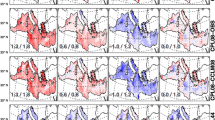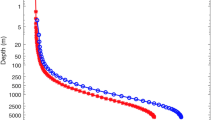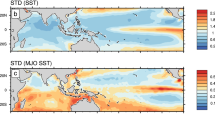Abstract
Here we show that coupling a high-resolution one-column ocean model to an atmospheric general circulation model dramatically improves simulation of the Madden–Julian oscillation (MJO) to have realistic strength, period, and propagation speed. The mechanism for the simulated MJO involves both frictional wave-convective conditional instability of the second kind (Frictional wave-CISK) and air–sea convective intraseasonal interaction (ASCII). In particular, better resolving the fine structure of upper ocean temperature, especially the warm layer, produces more vigorous atmosphere–ocean interaction and strengthens intraseasonal variations in both SST and atmospheric circulation. This helps organize and strengthen deep convection, inducing a stronger Kelvin-wave like perturbation and frictional near-surface convergence to the east. In addition, the warmer SST ahead of the MJO also acts to destabilize the boundary layer and enhance frictional convergence. These lead to a more realistic eastward-propagating MJO. A suite of sensitivity experiments were performed to show the robustness of the mechanisms and to demonstrate: (1) that mean state differences are not the main contributors to the improved simulation of our coupled model; (2) the role of SST variability in enhancing frictional convergence and intraseasonal variations in precipitation, and (3) that the simulation is significantly degraded when the first ocean model layer is thicker than 10 m. Our coupled model results are consistent with observations and demonstrate a simple but effective means to significantly improve MJO simulation and potentially also forecasts.















Similar content being viewed by others
Notes
Typically defined as the region of water warmer than 29 °C in the Indo-Pacific region.
References
Adler RF, Huffman GJ, Chang A, Ferraro R, Xie P-P, Janowiak J, Rudolf B, Schneider U, Curtis S, Bolvin D (2003) The version-2 global precipitation climatology project (GPCP) monthly precipitation analysis (1979-present). J Hydrometeorol 4(6):1147–1167
Ajayamohan R, Khouider B, Majda AJ (2013) Realistic initiation and dynamics of the Madden–Julian oscillation in a coarse resolution aquaplanet GCM. Geophys Res Lett 40(23):6252–6257
Andersen JA, Kuang Z (2012) Moist static energy budget of MJO-like disturbances in the atmosphere of a zonally symmetric aquaplanet. J Clim 25(8):2782–2804
Bernie D, Woolnough S, Slingo J, Guilyardi E (2005) Modeling diurnal and intraseasonal variability of the ocean mixed layer. J Clim 18(8):1190–1202
Bernie D, Guilyardi E, Madec G, Slingo J, Woolnough S, Cole J (2008) Impact of resolving the diurnal cycle in an ocean–atmosphere GCM. Part 2: a diurnally coupled CGCM. Clim Dyn 31(7–8):909–925
Chen SS, Houze RA Jr, Mapes BE (1996) Multiscale variability of deep convection in realation to large-scale circulation in TOGA COARE. J Atmos Sci 53(10):1380–1409
CLIVAR MJOWG (2009) MJO simulation diagnostics. J Clim 22(11):3006–3030
Crueger T, Stevens B, Brokopf R (2013) The Madden–Julian Oscillation in ECHAM6 and the introduction of an objective MJO metric. J Clim 26(10):3241–3257
Dee D, Uppala S, Simmons A, Berrisford P, Poli P, Kobayashi S, Andrae U, Balmaseda M, Balsamo G, Bauer P (2011) The ERA-Interim reanalysis: configuration and performance of the data assimilation system. Q J R Meteorol Soc 137(656):553–597
Deng L, Wu X (2010) Effects of convective processes on GCM simulations of the Madden–Julian oscillation. J Clim 23(2):352–377
Emanuel KA (1987) An air–sea interaction model of intraseasonal oscillations in the tropics. J Atmos Sci 44(16):2324–2340
Fairall C, Bradley EF, Godfrey J, Wick G, Edson JB, Young G (1996) Cool-skin and warm-layer effects on sea surface temperature. J Geophys Res 101(C1):1295–1308
Flatau M, Flatau PJ, Phoebus P, Niiler PP (1997) The feedback between equatorial convection and local radiative and evaporative processes: the implications for intraseasonal oscillations. J Atmos Sci 54(19):2373–2386
Gaspar P, Gregoris Y, Lefevre J-M (1990) A simple eddy kinetic energy model for simulations of the oceanic vertical mixing: tests at station papa and long-term upper ocean study site. J Geophys Res 95(C9):16179–16193
Gill AE (1980) Some simple solutions for heat-induced tropical circulation. Q J R Meteorol Soc 106(449):447–462
Hendon HH (2000) Impact of air–sea coupling on the Madden–Julian oscillation in a general circulation model. J Atmos Sci 57(24):3939–3952
Hendon HH, Liebmann B (1994) Organization of convection within the Madden–Julian oscillation. J Geophys Res Atmos (1984–2012) 99(D4):8073–8083
Hendon HH, Salby ML (1994) The life cycle of the Madden–Julian oscillation. J Atmos Sci 51(15):2225–2237
Hsu H-H, Weng C-H, Wu C-H (2004) Contrasting characteristics between the northward and eastward propagation of the intraseasonal oscillation during the boreal summer. J Clim 17(4):727–743
Hung M-P, Lin J-L, Wang W, Kim D, Shinoda T, Weaver SJ (2013) MJO and convectively coupled equatorial waves simulated by CMIP5 climate models. J Clim 26(17):6185–6214
Inness PM, Slingo JM (2003) Simulation of the Madden–Julian oscillation in a coupled general circulation model. Part I: comparison with observations and an atmosphere-only GCM. J Clim 16(3):345–364
Jiang X, Waliser DE, Xavier PK, Petch J, Klingaman NP, Woolnough SJ, Guan B, Bellon G, Crueger T, DeMott C, Hannay C, Lin H, Hu W, Kim D, Lappen C-L, Lu M–M, Ma H-Y, Miyakawa T, Ridout JA, Schubert SD, Scinocca J, Seo K-H, Shindo E, Song X, Stan C, Tseng W-L, Wang W, Wu T, Wyser K, Wu X, Zhang GJ, Zhu H (2014) Exploring key processes of the Madden–Julian Oscillation (MJO): a joint WGNE MJO task force/GEWEX GASS project on the vertical structure and diabatic processes of the MJO—part I. Climate Simulations. J Geophys Res Atmos (submitted)
Kang I-S, Liu F, Ahn M-S, Yang Y-M, Wang B (2013) The role of SST structure in convectively coupled Kelvin–Rossby waves and its implications for MJO formation. J Clim 26(16):5915–5930
Kim D, Sperber K, Stern W, Waliser D, Kang I-S, Maloney E, Wang W, Weickmann K, Benedict J, Khairoutdinov M (2009) Application of MJO simulation diagnostics to climate models. J Clim 22(23):6413–6436
Kim D, Sobel AH, Maloney ED, Frierson DM, Kang I-S (2011) A systematic relationship between intraseasonal variability and mean state bias in AGCM simulations. J Clim 24(21):5506–5520
Kiranmayi L, Maloney ED (2011) Intraseasonal moist static energy budget in reanalysis data. J Geophys Res 116:D21117. doi:10.1029/2011JD016031
Klingaman NP, Woolnough SJ, Weller H, Slingo JM (2011) The impact of finer-resolution air–sea coupling on the intraseasonal oscillation of the Indian monsoon. J Clim 24(10):2451–2468
Lin J-L, Kiladis GN, Mapes BE, Weickmann KM, Sperber KR, Lin W, Wheeler MC, Schubert SD, Del Genio A, Donner LJ (2006) Tropical intraseasonal variability in 14 IPCC AR4 climate models. Part I: convective signals. J Clim 19(12):2665–2690
Lindzen RS, Nigam S (1987) On the role of sea surface temperature gradients in forcing low-level winds and convergence in the tropics. J Atmos Sci 44(17):2418–2436
Liu P, Wang B, Sperber KR, Li T, Meehl GA (2005) MJO in the NCAR CAM2 with the Tiedtke convective scheme. J Clim 18(15):3007–3020
Madden RA, Julian PR (1972) Description of global-scale circulation cells in the tropics with a 40–50 day period. J Atmos Sci 29(6):1109–1123
Maloney ED (2009) The moist static energy budget of a composite tropical intraseasonal oscillation in a climate model. J Clim 22(3):711–729
Maloney ED, Hartmann DL (1998) Frictional moisture convergence in a composite life cycle of the Madden–Julian oscillation. J Clim 11(9):2387–2403
Maloney ED, Sobel AH (2004) Surface fluxes and ocean coupling in the tropical intraseasonal oscillation. J Clim 17(22):4368–4386
Marshall AG, Alves O, Hendon HH (2008) An enhanced moisture convergence-evaporation feedback mechanism for MJO air–sea interaction. J Atmos Sci 65(3):970–986
Nakazawa T (1988) Tropical super clusters within intraseasonal variations over the western Pacific. J Meteorol Soc Jpn 66(6):823–839
Neelin JD, Held IM, Cook KH (1987) Evaporation-wind feedback and low-frequency variability in the tropical atmosphere. J Atmos Sci 44(16):2341–2348
Nordeng TE (1994) Extended versions of the convective parametrization scheme at ECMWF and their impact on the mean and transient activity of the model in the tropics. European Centre for Medium-Range Weather Forecasts
Paulson CA, Simpson JJ (1981) The temperature difference across the cool skin of the ocean. J Geophys Res 86(C11):11044–11054
Reynolds RW, Smith TM (1995) A high-resolution global sea surface temperature climatology. J Clim 8(6):1571–1583
Roeckner E (2003) The atmospheric general circulation model ECHAM5: part 1: model description. Max-Planck-Institut fuer Meteorologie, Germany
Saunders PM (1967) The temperature at the ocean–air interface. J Atmos Sci 24(3):269–273
Shinoda T, Hendon HH (1998) Mixed layer modeling of intraseasonal variability in the tropical western Pacific and Indian Oceans. J Clim 11(10):2668–2685
Sperber KR, Gualdi S, Legutke S, Gayler V (2005) The Madden–Julian oscillation in ECHAM4 coupled and uncoupled general circulation models. Clim Dyn 25(2–3):117–140
Subramanian AC, Jochum M, Miller AJ, Murtugudde R, Neale RB, Waliser DE (2011) The Madden–Julian oscillation in CCSM4. J Clim 24(24):6261–6282. doi:10.1175/JCLI-D-11-00031.1
Tiedtke M (1989) A comprehensive mass flux scheme for cumulus parameterization in large-scale models. Mon Weather Rev 117(8):1779–1800
Tsuang B-J, Tu C-Y, Tsai J-L, Dracup JA, Arpe K, Meyers T (2009) A more accurate scheme for calculating Earths-skin temperature. Clim Dyn 32(2–3):251–272
Tu C-Y, Tsuang B-J (2005) Cool-skin simulation by a one-column ocean model. Geophys Res Lett 32:L22602. doi:10.1029/2005GL024252
Waliser DE, Lau K, Kim J-H (1999) The influence of coupled sea surface temperatures on the Madden–Julian oscillation: a model perturbation experiment. J Atmos Sci 56(3):333–358
Wang B, Rui H (1990) Dynamics of the coupled moist Kelvin–Rossby wave on an equatorial-plane. J Atmos Sci 47(4):397–413
Watterson I (2002) The sensitivity of subannual and intraseasonal tropical variability to model ocean mixed layer depth. J Geophys Res Atmos (1984–2012) 107 (D2):ACL 12-11–ACL 12-15
Watterson I, Syktus J (2007) The influence of air–sea interaction on the Madden–Julian oscillation: the role of the seasonal mean state. Clim Dyn 28(7–8):703–722
Wheeler MC, Hendon HH (2004) An all-season real-time multivariate MJO index: development of an index for monitoring and prediction. Mon Weather Rev 132(8):1917–1932
Woolnough SJ, Slingo JM, Hoskins BJ (2000) The relationship between convection and sea surface temperature on intraseasonal timescales. J Clim 13(12):2086–2104
Woolnough S, Vitart F, Balmaseda M (2007) The role of the ocean in the Madden–Julian oscillation: implications for MJO prediction. Q J R Meteorol Soc 133(622):117–128
Wu J (1985) On the cool skin of the ocean. Bound-Layer Meteorol 31(2):203–207
Yanai M, Chen B, Tung W-w (2000) The Madden–Julian oscillation observed during the TOGA COARE IOP: global view. J Atmos Sci 57(15):2374–2396
Zhang C (2005) Madden–Julian Oscillation. Rev Geophys 43:RG2003. doi:10.1029/2004RG000158
Zhang GJ, Mu M (2005) Simulation of the Madden–Julian oscillation in the NCAR CCM3 using a revised Zhang–McFarlane convection parameterization scheme. J Clim 18(19):4046–4064
Zhang C, Dong M, Gualdi S, Hendon HH, Maloney ED, Marshall A, Sperber KR, Wang W (2006) Simulations of the Madden–Julian oscillation in four pairs of coupled and uncoupled global models. Clim Dyn 27(6):573–592
Zhou L, Neale RB, Jochum M, Murtugudde R (2012) Improved Madden–Julian oscillations with improved physics: the impact of modified convection parameterizations. J Clim 25(4):1116–1136
Zhu H, Hendon H, Jakob C (2009) Convection in a parameterized and superparameterized model and its role in the representation of the MJO. J Atmos Sci 66(9):2796–2811
Acknowledgments
The Deutsches Klimarechenzentrum, the Norddeutscher Verbund für Hoch- und Höchstleistungsrechnen and Taiwan/NCHC provided computing resources. The Deutsches Forschungsgemeinschaft under the Emmy Noether-Programm (KE 1471/2-1), the German BMBF NORDATLANTIK project, DFG-NSC international cooperation Grant, and EU SUMO (266722) and, STEPS (PCIG10-GA-2011-304243), and PREFACE (603521) projects provided financial support. The National Science Council, Taiwan, also supported the work (Grant NSC-100-2119-M-001-029-MY5; NSC 99-2111-M-005-001-MY3; NSC 102-2627-B-005-006-). We are grateful to the National Center for High-performance Computing for computer time and facilities. The Max Planck Institute for Meteorology provided the ECHAM5.
Author information
Authors and Affiliations
Corresponding author
Electronic supplementary material
Below is the link to the electronic supplementary material.
Rights and permissions
About this article
Cite this article
Tseng, WL., Tsuang, BJ., Keenlyside, N.S. et al. Resolving the upper-ocean warm layer improves the simulation of the Madden–Julian oscillation. Clim Dyn 44, 1487–1503 (2015). https://doi.org/10.1007/s00382-014-2315-1
Received:
Accepted:
Published:
Issue Date:
DOI: https://doi.org/10.1007/s00382-014-2315-1




